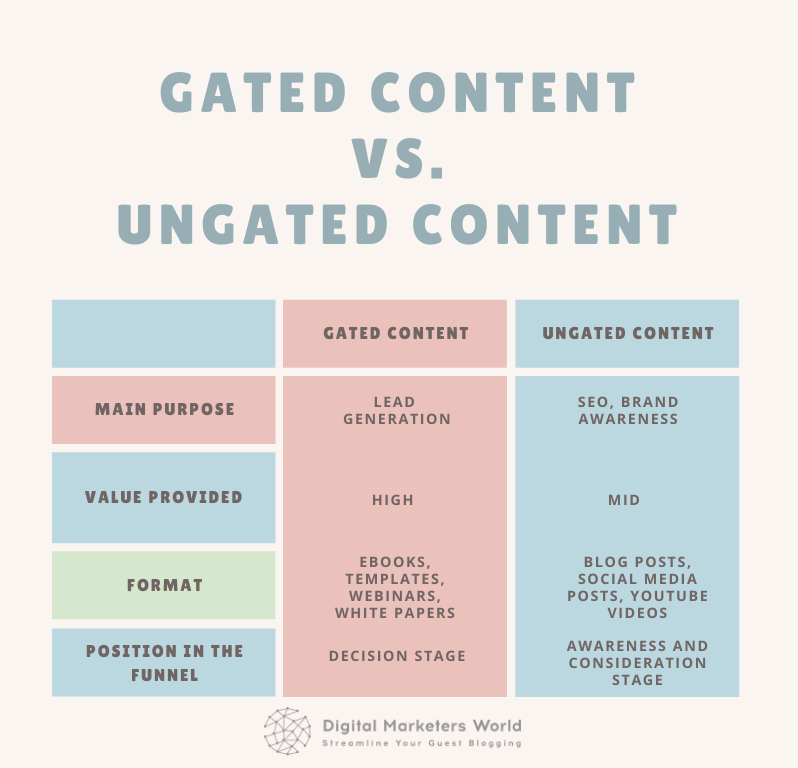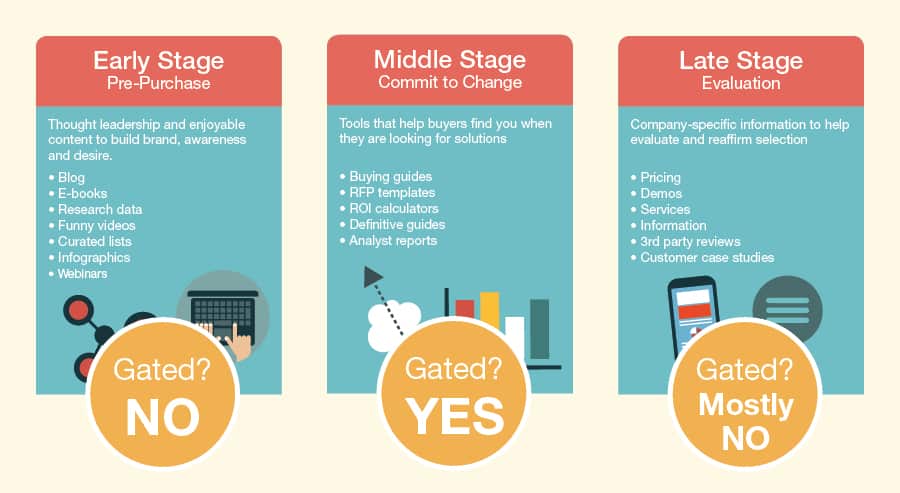Unlock the secrets of successful content marketing with our breakdown of what gated content is and how it can benefit you.

Image courtesy of via DALL-E 3
Table of Contents
Welcome to the exciting world of websites and content! Today, we’re going to talk about something called “gated content.” So, what exactly is gated content, and why is it used on websites? Let’s find out together!
What is Gated Content?
Let’s start with the basics. Gated content is like a special secret on a website that you can only access if you sign up for it. It’s like having a password to enter a cool club where all the good stuff is hidden behind a virtual gate.
Why is it Used?
Websites use gated content for a bunch of reasons. One big reason is to get your email or contact information when you sign up to see the hidden content. It’s kind of like a digital trade – you get to see the cool stuff, and they get a way to keep in touch with you.
Now that we’ve dipped our toes into what gated content is and why it’s used, let’s dive deeper into the different types you might come across on the web. Stick around to learn more!
Types of Gated Content
When you visit a website, you might come across different types of gated content. These are special goodies that you can only access after signing up for them. Let’s take a look at some common forms of gated content:
Ebooks
Ebooks are like digital books that you can read on your computer, tablet, or phone. Some websites offer these ebooks as gated content, meaning you have to provide your email or other information to download them.
Webinars
Webinars are online seminars or workshops where experts share valuable information. To join a webinar, you often need to sign up by providing your name and email. It’s a great way to learn new things!
Whitepapers
Whitepapers are detailed reports or guides on specific topics. They are usually packed with valuable insights and data. Websites sometimes gate whitepapers, so you need to fill out a form to access them. It’s like unlocking a treasure trove of information!
How Gated Content Works
Have you ever wondered how gated content actually works on websites? Let’s take a look at the simple steps involved in accessing this type of content.
Finding the Content
First things first, you come across a website that offers something interesting like an ebook, webinar, or whitepaper, but wait, there’s a catch! You can’t see it right away. This is because it’s gated content, which means you have to sign up to get access.
Sign-Up Form
So, you click on a button that says “Download Now” or “Access Content”, and a form pops up asking for some basic information like your name and email address. Websites do this to build their contact list and stay in touch with you.
Getting Access
Once you’ve filled out the form and hit the submit button, you are redirected to the content you wanted to see. Voila! You now have access to that special ebook or webinar you were curious about. It’s like unlocking a hidden treasure on the internet!
Benefits of Gated Content
One of the key benefits of gated content for website owners is the ability to collect valuable contact details from users. By requiring visitors to sign up or provide their email address to access the content, website owners can grow their mailing lists and reach out to potential customers with targeted marketing campaigns. This can lead to increased engagement and conversions, helping businesses achieve their goals.

Image courtesy of digitalmarketersworld.com via Google Images
For Users
From a user’s perspective, gated content can offer exclusive or valuable information that is not readily available elsewhere. By signing up to access the content, users can gain access to premium resources, in-depth insights, or expert knowledge that can help them solve a problem, learn something new, or improve a skill. This can provide users with a sense of value and exclusivity, making the sign-up process worthwhile.
Examples of Gated Content
HubSpot, a popular marketing platform, utilizes gated content to offer valuable marketing resources to its users. Visitors to the HubSpot website can access a plethora of guides, templates, and e-books related to marketing strategies, but to download these resources, users must provide their contact information by signing up. This approach not only enables HubSpot to collect valuable leads but also ensures that users receive targeted content tailored to their needs.
Example 2: LinkedIn Learning
LinkedIn Learning, a prominent online learning platform owned by LinkedIn, gates its courses behind a sign-up process. Users interested in accessing a wide array of professional courses on subjects ranging from business to technology are required to create a free account. By offering a sample of course content upfront and gating the rest, LinkedIn Learning entices users to sign up for a subscription to access the full range of courses available on the platform. This method helps LinkedIn Learning to grow its user base and retain paying customers who value the exclusive content provided.
When to Use Gated Content
In certain situations, employing gated content on a website can be beneficial. Let’s explore when it might be a good idea to use gated content.

Image courtesy of digitalmarketersworld.com via Google Images
Building an Email List
Gated content can be particularly useful when a website aims to grow its email list. By requiring users to sign up to access exclusive content, website owners can collect valuable contact details. This can help in sending targeted emails, newsletters, and promotions to a specific audience interested in the content offered.
Sharing In-Depth Information
When you have in-depth or exceptionally valuable information to share, gating the content can be a strategic move. This ensures that only those genuinely interested in the topic are accessing the material. By providing high-quality content behind a sign-up wall, you can add a sense of exclusivity and value, attracting a more engaged audience.
Challenges of Gated Content
One of the challenges of using gated content is that it may lead to a lower reach for your website. When content is gated, meaning users have to sign up to access it, some potential visitors may choose not to do so. This can result in fewer people seeing and engaging with your valuable content.
User Frustration
Another drawback of gated content is the potential for user frustration. Some visitors may find it annoying or time-consuming to fill out a form before accessing the desired information. This extra step in the process might deter users from engaging with your content, leading to a less favorable user experience on your website.
Alternatives to Gated Content
One alternative to gated content is the freemium model. In this model, websites offer basic content for free to all users. However, if users want access to premium or advanced content, they are required to pay a subscription fee. This way, users can still access some valuable information without having to give up their contact details.

Image courtesy of www.b2bmarketingworld.com via Google Images
Donation-Based Content
Another alternative to gated content is donation-based access. Some websites allow users to access content by making a donation instead of signing up. Users can choose to support the website by contributing financially, and in return, they gain access to the content they are interested in. This approach offers users a choice in how they engage with the content without the need for providing personal information.
Conclusion
In conclusion, gated content is a valuable tool used by websites to offer exclusive or premium content to users in exchange for their contact information. By understanding the basic concept of gated content and its various forms, users can navigate websites more effectively and access the information they desire.
The benefits of gated content are clear for both website owners and users. Website owners can gather valuable contact details and create a loyal audience, while users can access high-quality information that may not be readily available elsewhere.
While there are challenges to using gated content, such as potentially limiting the reach of the content and causing user frustration, these can often be mitigated by thoughtful design and implementation strategies.
Ultimately, the decision to use gated content on a website will depend on the goals and audience of the site. By understanding when to use gated content and being aware of alternatives, website owners can make informed decisions to best serve their users and achieve their objectives.
Want to turn these SEO insights into real results? Seorocket is an all-in-one AI SEO solution that uses the power of AI to analyze your competition and craft high-ranking content.
Seorocket offers a suite of powerful tools, including a Keyword Researcher to find the most profitable keywords, an AI Writer to generate unique and Google-friendly content, and an Automatic Publisher to schedule and publish your content directly to your website. Plus, you’ll get real-time performance tracking so you can see exactly what’s working and make adjustments as needed.
Stop just reading about SEO – take action with Seorocket and skyrocket your search rankings today. Sign up for a free trial and see the difference Seorocket can make for your website!
FAQs
Is Gated Content Free?
Gated content is usually free, but it requires you to sign up or provide some information in exchange for access. This could be your email address or other contact details. So, while you may not have to pay for the content with money, you do need to provide some information to access it.
Is My Information Safe?
Your information is generally safe when signing up for gated content on reputable websites. These websites have privacy policies in place to protect your data. Make sure to read the terms and conditions to understand how your information will be used. If a website is trustworthy, your information should be safe and secure.
Will I Get Spam Emails?
When you sign up for gated content on a reliable website, you shouldn’t receive spam emails. Legitimate websites value your privacy and will not misuse your contact information. However, it’s always a good idea to be cautious and ensure that you are signing up on a reputable site to avoid receiving unwanted emails.







